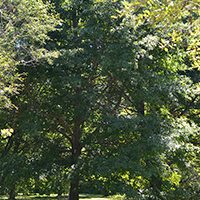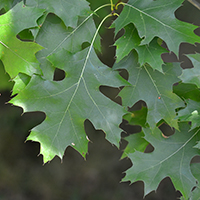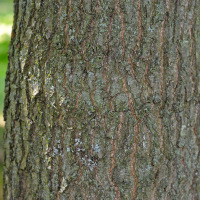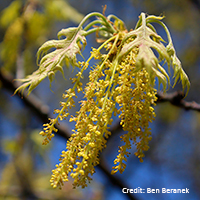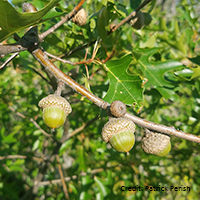What northern pin oak looks like
Size and shape
- Reaches 21 metres high.
- Trunk reaches up to 60 centimetres in diameter.
Leaves
- Dark green (7 to 12 centimetres) with toothed lobes separated by U-shaped notches.
- Turn bright red in the fall.
Bark
- Dark grey to brown with light yellow inner bark.
- Thin plates and shallow furrows.
Flowers
- Male flowers are green catkins (4 to 10 centimetres).
- Female flowers are small, grow in groups of 1 to 3 with red tube-like structures on a green stalk.
- Bloom mid-spring.
Fruit
- Acorns are elliptic (less than 2 centimetres) with a scaly reddish cap covering up to half of the nut, which has a striped pattern.
Where northern pin oak is found
Northern pin oak is uncommon in Ontario but can be found in Northwestern Ontario west of Lake Superior and in Southwestern Ontario north of Lake Erie.
What you need to know to grow northern pin oak
- Moisture: grows best in dry soils.
- Soil: grows best in sandy soils, and shallow soils over bedrock in Northwestern Ontario.
- Shade: grows best in full sun.
- Caution:
- oak wilt is caused by an invasive fungus that has been found in Southern Ontario. To minimize risk of oak wilt, save pruning for before April and after July, when beetles thought to transport the fungus are less active.
Benefits and uses of northern pin oak
Wildlife benefits
Northern pin oak acorns are a food source for many animals, including:
- blue jays
- wild turkeys
- white-tailed deer
- squirrels
Northern pin oak tree cavities are used as nesting sites by birds, such as wood ducks and Kirtland’s warbler.
Commercial uses
Northern pin oak trees are commonly planted as ornamental trees. The wood is often used to make fence posts and firewood.
Fun facts about northern pin oak
- Northern pin oak trees can hybridize with black oak and northern red oak trees.
Updated: October 18, 2023
Published: October 12, 2023
